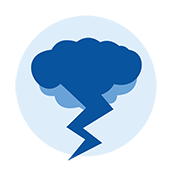Learn about landslidesHe ako mō ngā horo whenua
 Landslides are common in many parts of New Zealand because of our mountainous land, loose volcanic soil, and frequent earthquake activity. Weather and human activity can also cause landslides. Landslides can endanger buildings, livestock and people.
Landslides are common in many parts of New Zealand because of our mountainous land, loose volcanic soil, and frequent earthquake activity. Weather and human activity can also cause landslides. Landslides can endanger buildings, livestock and people.
On this page
What is a landslide?
A landslide is the movement of rock, soil and vegetation down a slope. Landslides can range in size from a single boulder to a large avalanche of debris spread across many kilometres. Landslides are a serious geological hazard in many parts of New Zealand.
Heavy rainfall or earthquakes can cause a landslide. Human activities can also cause landslides. These can include:
- removal of trees and vegetation
- steep roadside cuttings, or
- leaking water pipes.
Some warning signs are:
- small slips, rockfalls and sinking land at the bottom of slopes
- sticking doors and window frames, which may mean the land is slowly moving under the house
- gaps where window frames are not fitting properly
- steps, decks and verandas moving or tilting away from the rest of the house
- new cracks or bulges on the ground, road, footpath, retaining walls or other hard surfaces; and
- tilting trees, retaining walls or fences.
It’s important to recognise the warning signs and act quickly.
What do we do before a landslide?
- Find out if there have been landslides in your area before, and where they might occur again.
- Check for signs that the ground may be moving.
What do we do during a landslide?
- Act quickly. Getting out of the path of a landslide is your best protection.
- Evacuate, taking your grab bag and your pets with you.
- Warn neighbours who might be affected and help those who may need help to evacuate.
- Contact emergency services to inform them of the hazard.
What do we do after a landslide?
- Stay away from any landslides until they have been properly checked and officials give the all-clear.
Find out more about what to do before, during and after a landslide.
Home learning
 Make sure your school has the names of three people who could pick you up if your usual person can’t be there.
Make sure your school has the names of three people who could pick you up if your usual person can’t be there.
Make a plan with your family to get through an emergency. Think about the things you need every day and work out what you would do if you didn't have them.
Make your plan — print it out, stick it on the fridge and make sure everyone knows the plan.
Find out about past landslides that have happened in your region.
Learning resources

Visit this virtual field trip from Learnz. In this field trip, experts take you to remote locations to help you better understand what causes natural disasters.

Watch this GNS Science video explaining some of the processes and features of the Dart landslide.

Read a New Zealand perspective on landslides on Te Ara, the Encyclopedia of New Zealand.

Watch this video on landslides produced by National Geographic.

Watch these YouTube videos from GeoNet experts answering questions about natural hazards.
Learn about emergencies
Natural hazards can be frightening. They can strike at any time and often without warning. Explore the types of emergencies below and learn better ways to prepare.





